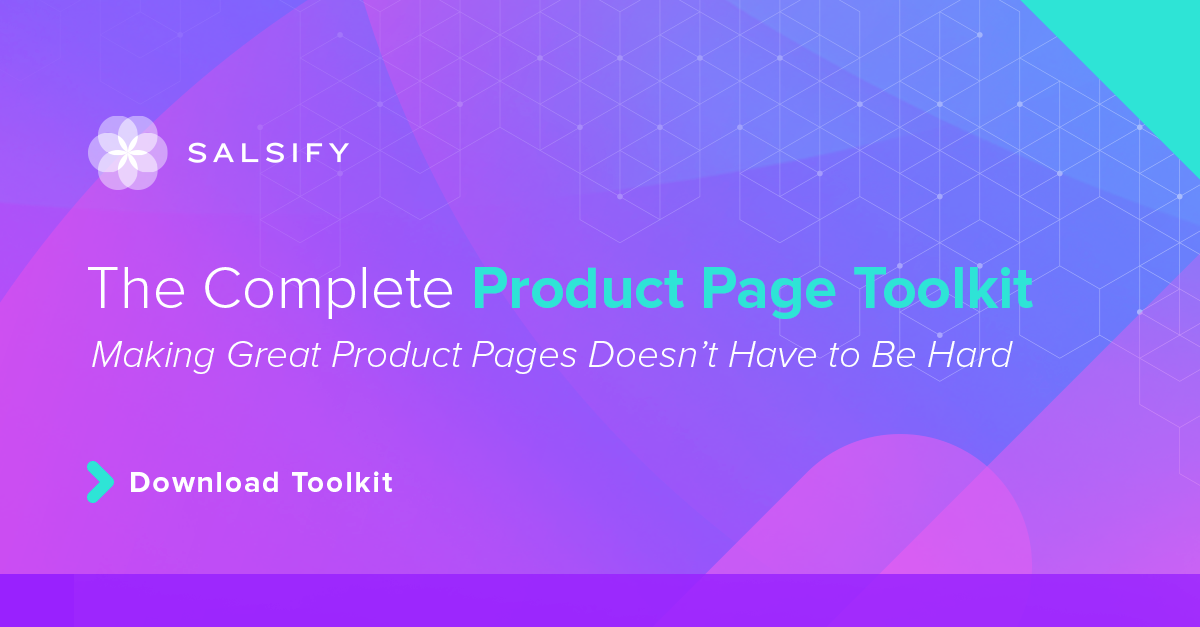

The Complete Product Page Toolkit
Download this product page toolkit to get everything you need to create engaging, high-performing product pages that drive sales and build trust with shoppers.
DOWNLOAD TOOLKITPIM
Manage all product content in one central system of record.
Syndication
Easily syndicate product content to every consumer touch point.
Enhanced Content
Enrich product pages with below-the-fold content and rich media.
Intelligence Suite
Bring AI-powered capabilities directly into your Salsify workflows.
Grocery Accelerator
Leverage the first-ever category-wide PXM accelerator in the grocery industry.
GDSN Data Pool
Synchronize standard supply chain, marketing, and ecommerce attributes globally.
Digital Shelf Analytics
Continuously optimize your organization’s product content syndication.
Catalog Sites
Share secure, on-brand, and always up-to-date digital product catalogs.
Automation and AI
Automate business processes and enhance Salsify workflows with AI.
PXM Platform, Integrations, and APIs
Integrate the PXM platform with the rest of your enterprise systems architecture.
Supplier Onboarding
Accelerate supplier onboarding while ensuring your schema requirements are met.
Product Listing
Sell products faster with Product Listing.
Content Enrichment
Increase online conversions with Content Enrichment.
Automation
Save time and increase operational efficiency with retail automation.
SXM Platform, Integrations, and APIs
Integrate the SXM platform with the rest of your enterprise systems architecture.
Syndication Network
Automate how you exchange product content data to the digital shelf.
Enhanced Content Network
Turn product pages into product experiences with Enhanced Content.
Commerce Platform Integrations
Create winning product experiences everywhere shoppers are, including on owned sites.
GDSN Data Pool
Synchronize standard supply chain, marketing, and ecommerce attributes globally.
Open Catalog
Connect to the digital shelf faster with an open, standardized, and free product catalog.
Resources
Resource Library
Explore our ecommerce resources to get everything you need to win on the digital shelf.
Blog
Read our blog to get actionable insights for navigating changing markets and industry demands.
Webinars
Watch our on-demand ecommerce webinars to gain expert advice and tips from our community of industry leaders.
Customer Blog
Gain the latest tips, industry trends, and actionable ecommerce insights.
Knowledge Base
Investigate our knowledge base to build your Salsify skills and understanding.
API
Examine our comprehensive API and webhook guides to start working with Salsify quickly.

Download the report to get expert insights, consumer research, and top industry trends.

Consumer packaged goods (CPG) companies have historically seen success selling in traditional brick-and-mortar retailers.
They're optimized for scale in these channels, rather than diversification and dispersion throughout multiple opportunities for consumers to buy. And, as a result, they’re struggling to keep up with the growing market online.
Pressures from new and old competitors and increasing online-only consumption patterns are forcing CPG companies to adapt or risk losing significant market share in their categories. Even the largest CPG brands struggle.
What are the main CPG marketing challenges brands face? What should they be concerned about? And how can they combat this market share disparity?
If consumer confidence is strong, and CPG brands are performing well overall, why should they be concerned about ecommerce share and digital commerce?
Here are some of the challenges that CPG brands are actively facing in today’s modern commerce environment.
Many online retailers have launched their own label of CPG products. Private-label brands offer everything from clean baby products to grocery items and household essentials.
They’re comparable to traditional CPG brands in quality, price, and ease of access.
Another growing trend in the market is the use of subscription services that eliminate the challenge of shopping brick-and-mortar by establishing set delivery shipments of necessary household items online.
This eliminates the need for consumers to consider and shop for products by increasing the reordering of products they already use.
DNVBs are highly specialized companies that sell products to a specific target audience. They typically start out with no physical retailing space, but that’s not to say that physical retail can’t play a role in their strategy.
DNVBs are cost-saving due to their direct-to-consumer (DTC) model. The middle-man markups that most traditional CPG brands experience are eliminated.
Additionally, these brands are getting support from venture capitalists, which only indicates their increasing and continued influence on market trends and consumer behaviors.
DNVBs are gaining popularity and market share quickly. The pandemic has created a unique opportunity for ecommerce brands to outshine CPGs, which means that traditional CPG brands need to be prepared to compete with these brands in all arenas, but especially online.
Some DNVBs to look out for are baby, beauty, and household products from The Honest Company and online grocery store Brandless. Brands like these are usually seen as honest, responsible and friendly.
While big changes are hard, there are some key themes to keep in mind that can help guide any organization forward.
Who is your target audience? Figure out who they are, and embrace them as the loyal, lifelong customers you expect them to be.
Gain their trust and keep it by continually striving to create products and experiences that demonstrate your authentic commitment to serving them.
Use every opportunity to reinforce this mission through your design and messaging on your brand website, social media channels, and wherever else you appear.
It's also imperative to rack up those page views and achieve visibility. You need to boost search results (both organic and paid).
Constantly refresh your product detail page to always reflect the best your product has to offer throughout the year. This may include new versions of the product, seasonal changes, or trying bundles and other offers.
Constantly measure your performance and respond. CPG companies need to experiment within the market to establish the correct strategy or risk losing market share.
Once products are at the top of a category, they're constantly rewarded with better search performance and conversions, but falling to the bottom means that products quickly cease to have relevance.
Implementing these strategies and improving your product detail pages will help your brand overcome CPG commerce marketing challenges.

Download this product page toolkit to get everything you need to create engaging, high-performing product pages that drive sales and build trust with shoppers.
DOWNLOAD TOOLKITStanding out on the digital shelf starts with access to the latest industry content. Subscribe to Below the Fold, our monthly content newsletter, and join other commerce leaders.